Did Betsy Ross Really Make The Flag
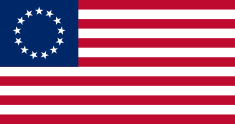 | |
| Use | |
|---|---|
| Proportion | 10:xix |
| Pattern | Thirteen alternating red and white stripes, a blueish canton with 13 v-pointed stars bundled in a circumvolve |
| Designed past | Various |
The Betsy Ross flag is a reconstructed early design for the flag of the United States, which is conformant to the Flag Act of 1777 and has red stripes outermost and stars arranged in a circumvolve. These details elaborate on the 1777 human action, passed early in the American Revolutionary War, which specified 13 alternate blood-red and white horizontal stripes and 13 white stars in a blue canton. It was once widely believed that, shortly after the 1777 deed, upholsterer and flag maker Betsy Ross produced a flag of this pattern.[1] : 107 In truth, this flag would have been unknown at the fourth dimension of the Revolutionary War co-ordinate to Grace Cooper, a onetime flag historian at the Smithsonian Institution. Cooper dates the earliest appearance of this flag every bit 1792 but with vi-pointed stars.[two] Configuration with crimson stripes outermost and five-point stars is at present standard for U.S. flags, although the stars are now arranged in horizontal rows.
The earliest connection between Betsy Ross and this flag design with 13 stars in a circumvolve was Charles Weisgerber's 1893 painting, "Birth of Our Nation's Flag."[iii] The 9 x 12-pes painting was first displayed at the 1893 Columbian Exposition in Chicago and depicts Betsy Ross with the flag on her lap.[iv] In developing his work, Weisgerber was in touch with the descendants of Betsy Ross.[5] He would take needed a blueprint for the flag in his painting. The most likely source of his pattern is the 1882 edition of History of the Flag of the Usa by George Henry Preble, a flag scholar in the late 1800s.[6] Preble himself did not discuss the arrangement of the stars on the 1777 design. The volume's illustrators, yet, did provide a flag design for the 1777 flag. The illustrators may accept used the flag design from Emanuel Leutze's 1851 painting, Washington Crossing the Delaware. Consequently, the editions of Preble'due south volume in 1872, 1880, and 1882, all prove the 1777 flag every bit having a circle of xiii stars. Information technology is also possible that Weisgerber used a July 1873 upshot of Harper's Weekly Magazine equally his source to detect out what a 1777 flag looked like. This commodity published one year subsequently Preble's outset edition, showed this flag with the label, "Flag Adopted by Congress, 1777."[7]
Preble states in his 1882 text that no 1 knows who designed the 1777 flag.[ citation needed ] He goes over the show provided by Betsy Ross' grandson, William J. Canby, in an 1870 newspaper to the Historical Gild of Pennsylvania. He also considers letters from Canby written after Canby delivered his paper. Preble concludes that no stars and stripes flag was in common use prior to the passing of the Flag Resolution in June 1777.[ citation needed ] As to the bodily pattern including stars and stripes, Preble thinks it may have come from the Marine Commission.[ commendation needed ]
Betsy Ross story [edit]
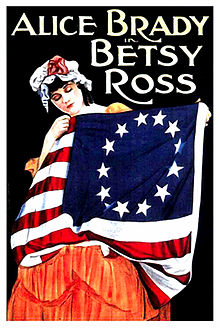
Betsy Ross (1752–1836) was an upholsterer in Philadelphia who produced uniforms, tents, and flags for Continental forces. She was likewise acquainted with George Washington, having known his wife Martha and as well doing sewing for him, making shirts and repairing his uniforms. Considering of this, he personally discussed with her the making of a national flag for the new nation. While she agreed with his design wholeheartedly, she did make ane alter in that, rather than the stars being half-dozen-pointed, they be v-pointed for as she stated, "A 5-pointed star could exist made with one snip". She went on to make the flag, and on June 14, 1777, the Continental Congress, seeking to promote national pride and unity, adopted the National Flag. "Resolved: that the flag of the United states exist 13 stripes, alternate red and white; that the wedlock exist thirteen stars, white in a blueish field, representing a new constellation."
Ross became a notable effigy representing the contribution of women in the American Revolution,[8] just how this specific blueprint of the U.S. flag became associated with her is unknown. An 1851 painting past Ellie Sully Wheeler of Philadelphia displayed Betsy Ross sewing a U.S. flag.[i] : 109 [9] The National Museum of American History suggests that the Betsy Ross story first entered into American consciousness virtually the time of the 1876 Centennial Exposition celebrations.[10]
In 1870, Ross'south grandson, William J. Canby, presented a newspaper to the Historical Society of Pennsylvania in which he claimed that his grandmother had "made with her hands the first flag" of the United States.[11] Canby said he outset obtained this data from his aunt Clarissa Sydney Wilson (née Claypoole) in 1857, 20 years later on Betsy Ross'southward death. In his business relationship, the original flag was made in June 1776, when a pocket-sized committee – including George Washington, Robert Morris and relative George Ross – visited Betsy and discussed the need for a new U.S. flag. Betsy accepted the task to manufacture the flag, altering the commission's design past replacing the six-pointed stars with five-pointed stars. Canby dates the celebrated episode based on Washington'southward journeying to Philadelphia, in late spring 1776, a year before Congress passed the Flag Human activity.[12] Ross biographer Marla Miller notes that even if one accepts Canby's presentation, Betsy Ross was merely one of several flag makers in Philadelphia, and her only contribution to the committee's design was the modify in star shape from 6-pointed to 5-pointed.[13] : 176
In 1878, Col. J. Franklin Reigart published a somewhat different story in his book, "The history of the first United States flag, and the patriotism of Betsy Ross, the immortal heroine that originated the first flag of the Union." Reigart remembers visiting his great aunt, Mrs. Betsy Ross, in 1824 during the time of Full general Lafayette'south visit to Philadelphia. In this version, Dr. Benjamin Franklin replaces George Washington. Together with George Ross and Robert Morris, they request that Mrs. Ross design the starting time flag. The Canby version and the subsequent 1909 volume with the Ross family affidavits never specify the arrangement of stars. Reigart, nevertheless, describes Mrs. Ross' flag with an eagle in the canton with xiii stars surrounding its caput. The cover of Reigart's book shows the thirteen stars in a 3-2-iii-2-3 lined blueprint in the canton.[fourteen]
The circumvolve pattern was again attributed to Elizabeth Griscom Ross in an 1893 painting by Charles H. Weisgerber.[xv] The nine ten 12 foot painting was outset displayed at the 1893 Columbian Exposition in Chicago. Weisgerber later helped start the foundation that restored 239 Arch Street in Philadelphia as The Betsy Ross House.[sixteen] Weisgerber promoted the story of Betsy Ross past sending prints of the painting to foundation donors. Information technology was reported in 1928 that he received donations from four one thousand thousand children and adults.[17] In 1897, the New York City School Board approved the order of framed prints for all schools in their system.[18]
Canby Account [edit]

Ross' grandson, William Canby, publicly presented a version of her story to the Historical Society of Pennsylvania in 1870.[19] Canby's 1870 account remains popular American folklore, but has been the source of some debate. Although the account has supporters, at that place is a lack of historical evidence and documentation to support Canby's story.[20] [a] Information technology is worth pointing out that while modern lore may exaggerate the details of her story, Canby's account of Betsy Ross never claimed any contribution to the flag design except for the five-pointed star.[21] : 32 [xiii] : 176
Additionally, arguments against Canby'southward story include:
- Despite Canby's efforts, he could find no records to show that the Continental Congress had a committee to pattern the national flag in the spring of 1776.[22]
- Although George Washington had been a fellow member of the First Continental Congress, he left Congress to become commander-in-principal of the Continental Army in 1775.[23] : 66 Therefore, it would take been impossible for him to head a congressional committee in 1776.
- In letters and diaries that accept surfaced, neither George Washington, Col. Ross, Robert Morris, nor whatsoever other member of Congress mentioned anything about a national flag in 1776.
- Six-pointed stars were used in the 1782 Great Seal that was based on the 1777 flag. The stars in the Great Seal were not changed to v-pointed stars until the Seal was recast in 1841.[24]
- The Flag Resolution of June 1777 was the start documented meeting, give-and-take, or debate by Congress about a national flag.
- On May 29, 1777, Betsy Ross was paid by the Pennsylvania State Navy Board for making Pennsylvania naval flags, not the Stars and Stripes.[23] : 117
Supporters of Canby's story defend his business relationship with arguments including:
- Robert Morris was a business organization partner of John Ross, Betsy's cousin by spousal relationship. Morris was on the Marine Committee at the fourth dimension the flag vote was taken as part of Marine Committee business.[25]
- George Washington has at least one documented transaction with John and Betsy Ross, when he bought bed hangings from them in 1774.[26]
- George Washington was in Philadelphia in May and June 1776 for fifteen days. Subsequent to his coming together with Congress during this fourth dimension, a committee was formed to confer with Washington on war machine options. The membership included George Read, the uncle of John Ross, tardily husband of Betsy Ross.[thirteen] : 173
- Rachel Fletcher, Betsy Ross'south daughter, gave an affidavit to the Betsy Ross story.[27]
- A painting which might be dated 1851 by Ellie Wheeler, allegedly the daughter of Thomas Sully, shows Betsy Ross sewing the flag. If the painting is authentic and the date correct, the story was known nearly 20 years before Canby's presentation to the Historical Social club of Pennsylvania.[28]
"First Flag" [edit]

The "Betsy Ross" flag is featured on the seal of the U.Southward. Department of Veterans Affairs, together with the mod United States flag to represent veterans throughout United States history.[29]
Canby's account and similar versions of the Betsy Ross tale oft refer to this design every bit the "first U.Southward. flag", but there is no consensus on what the first U.Southward. flag looked similar, nor who produced it. There were at least 17 flag makers and upholsterers who worked in Philadelphia during the time these early American flags were made. Margaret Manny is thought to accept fabricated the starting time Continental Colors (or Grand Union Flag), merely at that place is no evidence to testify she also made the Stars and Stripes. Other flag makers of that period include Rebecca Young, Anne King, Cornelia Bridges, and flag painter William Barrett. Hugh Stewart sold a "flag of the United Colonies" to the Commission of Safe, and William Alliborne was ane of the offset to manufacture United States ensigns.[13] : 161 Any flag maker in Philadelphia could have sewn the first American flag. Even according to Canby, there were other variations of the flag being fabricated at the aforementioned time Ross was sewing the blueprint that would bear her proper noun. If truthful, in that location may not be 1 "first" flag, simply many.
The Marine Committee of the 2nd Continental Congress passed a Flag Resolution on June 14, 1777, establishing the commencement congressional description of official United States ensigns. The shape and arrangement of the stars is not mentioned – there were variations – but the legal description legitimized the Ross flag and similar designs.
Resolved, That the flag of the thirteen Us exist thirteen stripes, alternate red and white; that the marriage be thirteen stars, white in a blue field, representing a new constellation.[xxx]
As belatedly as 1779, the State of war Board of the Continental Congress had even so not settled on what the Army Standard of the United States should look similar. The Board sent a alphabetic character to Full general Washington asking his opinion, and submitting a design that included a serpent, too as a number corresponding to the state that flew the flag.[23] : 118
Francis Hopkinson is often given credit for a number of thirteen-star arrangements, including the Betsy Ross design. In a 1780 letter of the alphabet to the Continental Lath of Admiralty dealing with the Admiralty seal,[31] : 44 Hopkinson mentioned patriotic designs he created in the past few years, including "the Flag of the United States of America." He asked for compensation for his designs, but his claim for full bounty was rejected. Hopkinson was not the merely person consulted on designing the Great Seal of the United States. Furthermore, he was a public retainer and thus was already on the government'south payroll.[31] : 48
Historian Laurel Thatcher Ulrich argues that there was no "first flag" worth arguing over.[32] Ross biographer Marla Miller asserts that the question of Betsy Ross' involvement in the flag should non be one of blueprint, but of production and entrepreneurship.[26] Researchers accept that the U.s.a. flag evolved, and did not have ane design. In fact, Grace Cooper'south research for the Smithsonian Institution found 17 examples of 13-star flags that were in existence betwixt 1779 and ca. 1796.[33] Marla Miller writes, "The flag, similar the Revolution it represents, was the work of many hands."[13] : 181
Symbolism [edit]

Because the flag evolved during the American Revolutionary War, the pregnant of the blueprint is uncertain. Historians and experts discredit the common theory that the stripes and five-pointed stars derived from the Washington family glaze of arms.[34] While this theory adds to Washington's legendary involvement in the development of the first flag, no evidence exists to testify a connexion between his coat of arms and the flag, other than that his coat of arms has stars and stripes in information technology. Washington oft used his family coat of artillery with iii five-pointed scarlet stars and three ruddy-and-white stripes, on which is based the flag of the District of Columbia.
Stripes [edit]
During the Revolutionary War era and into the 19th century, the "Rebellious Stripes" were considered every bit the most of import chemical element of United States flags, and were near e'er mentioned before the stars.[21] : 29 The usage of stripes in the flag may be linked to two pre-existing flags. A 1765 Sons of Liberty flag flown in Boston had nine ruby and white stripes, and these "rebellious stripes" would influence later designs leading up to the American Revolution.[35] A flag used by Captain Abraham Markoe's Philadelphia Low-cal Horse Troop in 1775 had 13 blue and silver stripes.[36] One or both of these flags probable influenced the blueprint of the American flag.
Stars [edit]
The canton, featuring the stars, may have gradually replaced the Grand Union flag as hope for reconciliation faded.[37] Regimental flags featuring stars in a blue canton, such as those of the Green Mount Boys or 1st Rhode Island Regiment, may have pre-dated the 1777 Flag Resolution.[37] Stars were of import symbols in European heraldry, their pregnant differing with the shape and number of points. Stars appear in colonial flags as early every bit 1676.[b] Some accept speculated that stars may be linked to Freemasonry, but stars of this type were not an important icon in Freemasonry.[38] Although early on American flags featured stars with diverse numbers of points, the five-pointed star is a defining characteristic of the Betsy Ross legend. The v-pointed star became the norm on Navy ensigns, perhaps because five-pointed stars were more clearly defined from a distance.[21] : 64
Circumvolve [edit]

The shape and arrangement of the stars varied widely throughout the 18th and 19th centuries, and remains undefined by the various flag acts. In the late 18th century, a circle of stars, also known as a "wreath"[21] : 44 or "medallion" organisation,[39] : 34 was a favorite for painters and coin designers, equally well as some flag makers.[39] : 34 The circle generally represented unity between the states, with no state more dominant than any other.[forty] Circular arrangements similar to the "Betsy Ross" pattern were seen as early as 1777 at the surrender of General John Burgoyne at Saratoga. Eyewitness Alfred Street wrote:
The stars were disposed in a circle, symbolizing the perpetuity of the Union; the ring, like the circumvoluted snake of the Egyptians, signifying eternity. The thirteen stripes showed with the stars the number of the United Colonies, and denoted the subordination of the States to the Wedlock, as well every bit equality amid themselves."[40] [c]
A flag with a circumvolve of stars was again establish in 1782, in William Barton's 2nd design for the Great Seal of the United States. Barton described the circle equally a "symbol of eternity."[13] : 176 Ironically, although the circumvolve of stars is a characteristic of the "Betsy Ross" design, none of Betsy Ross' family documents mention this arrangement. Coexisting evidence from the Betsy Ross House suggests that Betsy Ross may have bundled her stars in rows.[13] : 176
Colors [edit]
Early United states of america flags used a wide variety of colors,[21] : 25 and at that place is no known documented meaning behind the colors of the flag until Charles Thomson, in his 1782 report to Congress on the Great Seal of the United States, wrote "The colours of the pales are those used in the flag of the U.s. of America. White signifies purity and innocence. Red hardiness and valour and Bluish the colour of the Main signifies vigilance perseverance and justice."[42] The apply of ruby-red and blue in flags at this time in history may derive from the relative fastness of the dyes indigo and cochineal, providing blue and crimson colors respectively, as aniline dyes were unknown. However, the most simple explanation for the colors of the American flag is that it was modeled after British flags. For instance, the Grand Union Flag, a predecessor to early stars and stripes designs, was probable based on the King's Colours or East India Company flag.
Political and cultural significance [edit]
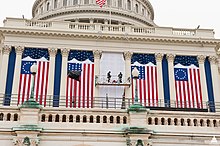
The "Betsy Ross" design is traditionally displayed at United states presidential inaugurations. Here, at the commencement inauguration of Barack Obama, it is flown next to a 21 star flag representing the American flag at the time that Illinois joined the Union.[43] [44]
The "Betsy Ross" design, with its easily identifiable circle of stars, has long been regarded as a symbol of the American Revolution and the young Democracy.[45] William J. Canby's recounting of the outcome appealed to Americans eager for stories almost the revolution and its heroines. Betsy Ross was promoted equally a patriotic role model for young girls and a symbol of women's contributions to American history.[46]
The Betsy Ross flag design is featured prominently in a number of post-Revolutionary paintings about the war, such as General George Washington at Trenton (1792)[d] and Washington Crossing the Delaware (1851). During the United states of america centennial, not long later on the presentation by William Canby, the Betsy Ross design became a highly produced and popular flag.[23] : 207
The traditional backdrop at quadrennial United States presidential inaugurations uses a big Betsy Ross flag and the modern US flag to represent the history of the nation. Since the 1980s, this display also includes a US flag pattern symbolizing the yr the president'due south habitation state was admitted to the union. During the inaugurations of Donald Trump and Joe Biden, the Betsy Ross flag was placed next to another xiii-star "Hopkinson" flag blueprint to represent united states of america of New York and Delaware, respectively.[48] [49]
The circle of 13 stars, which defines the "Betsy Ross" design, is found on two country flags: the Flag of Rhode Isle and the Flag of Indiana. The Flag of Missouri features a similar circumvolve of 24 stars, since it was admitted equally the 24th state. The United States Foreign Service flag also features the circle of 13-stars.
Since 1963, the Philadelphia 76ers have used the distinctive ring of 13 v-pointed stars in their team logo,[50] as a reference to Philadelphia as the outset United States uppercase, where the Declaration of Independence was signed and where Betsy Ross worked.
U.Due south. stamp stamps featuring the Betsy Ross flag design
-
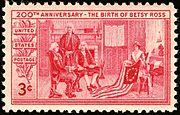
3¢ postage stamp issued in 1952 to commemorate Betsy Ross' 200th altogether.[51]
-
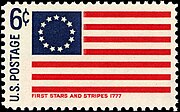
A 6¢ stamp with the Betsy Ross pattern was released in 1968 as role of the "Historic Flag" serial.[52]
-

10¢ stamp released in 1973, showing a l-star flag and a Betsy Ross flag together, to commemorate the The states Bicentennial.[53]
-

1975 13¢ stamp features the Betsy Ross flag behind Independence Hall[54]
Encounter as well [edit]
- Cowpens flag
- Flag of the United states
- One thousand Union Flag
Notes [edit]
- ^ See external links for arguments for and against Canby's story.
- ^ Portsmouth and Providence both featured flags with stars by 1680.[21] : 32
- ^ George Henry Preble's 1880 edition of his History of the American Flag finds Alfred Street's "poetic and fanciful" business relationship to be unsubstantiated by any contemporaneous proof.[41]
- ^ Grace Rogers Cooper writes "In 1792, Trumbull painted xiii stars in a circle in his General George Washington at Trenton in the Yale University Fine art Gallery. In his unfinished rendition of the Give up of Cornwallis at Yorktown, engagement non established, the circle of stars is suggested and i star shows six points while the thirteen stripes are of red, white, and blue. How accurately the artist depicted the star design that he saw is not known. At times, he may have offered a poetic version of the flag he was interpreting which was later copied by the flag maker. The flag sheets and the artists do not agree.{...} Star arrangement Number of star points Colors of stripe Primeval usage {...} (13 stars in a circle) non visible reddish, white 1792[47]
References [edit]
- ^ a b Vile, John R (2018). The American flag : an encyclopedia of the Stars and Stripes in U.S. history, culture, and law. Santa Barbara, CA: ABC-CLIO. ISBN978-1-4408-5788-i. LCCN 2018010859.
- ^ Cooper 1973.
- ^ Harker, John Balderston (2005). Betsy Ross's Five Pointed Star. Melbourne Beach, Florida: Canmore Press. p. 94.
- ^ "Renovations work sought for Betsy Ross painting 'Birth of Our Nation's Flag,' stored for thirty years, needs $25,000 in repairs". The Baltimore Sun. March one, 1998. Retrieved Nov 8, 2021.
- ^ Miller 2010, p. 358.
- ^ Preble, George Henry (1882). History of the Flag of the Usa of America, third Edition. Boston, Massachusetts: James R. Osgood. p. 248.
- ^ Wilcox, H. 1000. W. "National Standards and Emblems". Harper's New Monthly Magazine. 47: 178.
- ^ "History of American Women". Apr 17, 2010. Retrieved July 3, 2019.
- ^ Harker, John B (2005). "Betsy Ross: An American Fable and Patriot Revisited" (PDF). Raven. North American Vexillological Association. 12: 97. doi:10.5840/raven2005124. ISSN 1071-0043.
- ^ The Star-Spangled Banner, Lonn Taylor, Kathleen Grand. Kendrick, and Jeffrey L Brodie. Smithsonian Books/Collins Publishing (New York:2008)
- ^ Buescher, John. "All Wrapped upward in the Flag". Teachinghistory.org . Retrieved August 21, 2011.
- ^ Canby, William (March 1870). "The History of the Flag of the United States". Betsy Ross and the American Flag . Retrieved November 16, 2019 – via ushistory.org.
- ^ a b c d east f g Miller (2010).
- ^ Reigart, Col. J. Franklin (1878). The history of the offset United States flag. Harrisburg, Pennsylvania: Lane South. Hart.
- ^ "Birth of our Nation'south Flag". LOC.gov. Library of Congress. 1893. Retrieved November 1, 2019.
- ^ Worden, Amy (January 13, 2002). "Betsy Ross painting finds a new home". Baltimore Lord's day . Retrieved November 1, 2019.
- ^ Henderson, Jessie (1928). "Doubt is bandage on Betsy Ross every bit Mother of American flag". Sunday Wedlock and Republican, Springfield, Massachusetts.
- ^ Journal of the Board of Education of the City of New York. New York: Hall of the Board of Education. 1897. p. 300.
- ^ Laura, Schumn (July 9, 2019). "Did Betsy Ross really brand the first American flag?". History.
- ^ Leepson (2004), p. 50.
- ^ a b c d east f Mastai & Mastai (1973).
- ^ Balderston, Lloyd (1917). The Evolution of the American Flag. Philadelphia: Ferris and Leach. , Preface (start page) and p. 47-48
- ^ a b c d Furlong, William; McCandless, Byron (1981). And then Proudly Nosotros Hail. The History of the Usa Flag . Washington, DC: Smithsonian Institution Press. ISBN0-87474-448-ii.
- ^ "The Bang-up Seal of the United States" (PDF). U.Southward. Department of State Agency of Public Affairs. Retrieved October 24, 2019.
- ^ Letters of Delegates to Congress May seven-Sept. 18, 1777 Volume 7:204–6
- ^ a b Miller, Marla R. (June 2016). "Citizen Seamstress". The American Legion. Vol. 180. Indianapolis: The American Legion. pp. 32–36.
- ^ "Affidavit of Rachel Fletcher, a daughter of Elizabeth Claypoole (Betsy Ross)". Betsy Ross and the American Flag. July 31, 1871. Retrieved November 16, 2019 – via ushistory.org.
- ^ "Betsy Ross Flag". Revolutionary War and Across. October 19, 2011. Retrieved July 2, 2019.
- ^ "The Seal of the Department of Veterans Affairs" (PDF). United States Department of Veterans Diplomacy. Retrieved August 16, 2019.
- ^ "Journals of the Continental Congress, 1774–1789, Saturday, June 14, 1777". Library of Congress. p. 464. Retrieved November 16, 2019.
- ^ a b Williams, Jr., Earl P. (Spring 1988). "The 'Fancy Work' of Francis Hopkinson: Did He Design the Stars and Stripes?". Prologue (Quarterly of the National Archives). 20 (1): 42–52.
- ^ Ulrich, Laurel Thatcher (October 2007). "How Betsy Ross Became Famous". Common-Place. Vol. eight, no. one. Archived from the original on April 4, 2009. Retrieved February 15, 2009.
- ^ Cooper (1973), pp. x–11.
- ^ Hall, Edward (January 7, 1914). "The American Flag; Not Derived From Washington'due south Glaze of Artillery". The New York Times. p. 10.
- ^ "The "Rebellious Stripes" of the "Sons of Liberty"". The Historical Flag Projection. The United States District Court for the Commune of Puerto Rico. Retrieved July 22, 2019.
- ^ Johnson, Robert (2006). Saint Croix 1770–1776: The Offset Salute to the Stars and Stripes. AuthorHouse. p. 20. ISBN978-1-4259-7008-6.
This same Abraham Markoe, in 1775, organized the Calorie-free Horse Troop of Philadelphia, and presented the troop with what is considered the offset flag with xiii stripes representing the xiii colonies.
- ^ a b Hinrichs, Kit; Hirasuna, Delphine (2001). Long May She Wave: A Graphic History of the American Flag. Berkeley, California: 10 Speed Press. p. 11. ISBN978-1580082402.
- ^ Mackey, Albert Gallatin (1909). Mackey's Encyclopedia of Freemasonry.
- ^ a b Kiem, Kevin; Kiel, Peter (2007). A 1000 Old Flag: A History of the Usa Through its Flags. New York City: DK Publishing. ISBN978-0756628475.
- ^ a b Znamierowski (2002), p. 113.
- ^ Preble, George Henry (1880). History of the Flag of the United States of America (Second ed.). Boston: A. Williams and Company. pp. 262–264.
- ^ "Journals of the Continental Congress, 1774–1789, Thursday, June 20, 1782". Library of Congress. p. 339. Retrieved November 16, 2019.
- ^ Palma, Bethania. "Were Betsy Ross Flags Flown at Obama'due south Inauguration?". Retrieved July six, 2019.
- ^ Stolberg, Sheryl (January 21, 2013). "Interesting Facts Almost Inauguration". The New York Times . Retrieved Baronial xiii, 2019.
- ^ "Symbols of a New Nation". The Star-Spangled Banner: The Flag that Inspired the National Anthem. National Museum of American History. Retrieved July 4, 2019.
- ^ Taylor, Lonn; Kendrick, Kathleen Yard.; Brodie, Jeffrey (2008). "What Well-nigh Betsy Ross". The Star-Spangled Imprint: The Making of an American Icon (1st ed.). Washington, DC: Smithsonian Institution. p. 69. ISBN978-0-06-088562-5.
- ^ Cooper (1973), pp. 9, 11.
- ^ Pihl, Anton (Jan twenty, 2017). "What'southward With The Flags Behind The President?". Retrieved Baronial 14, 2019.
- ^ Carnett, Lindsey (December 11, 2020). "SA-based flag company makes US flags for Biden'due south inauguration". San Antonio Publisher . Retrieved January 20, 2020.
- ^ "Philadelphia 76ers logo". k Logos . Retrieved January 20, 2020.
- ^ Smithsonian National Postal Museum
- ^ "Women on Stamps: Betsy Ross". National Postal Museum. Smithsonian Institution. Retrieved July viii, 2019.
- ^ "Long May It Moving ridge: The Story of The American Flag Through Stamps. Resolved, That the flag of the U.s.a...." Smithsonian Establishment. Retrieved July viii, 2019.
- ^ "13c Flag Over Independence Hall single". National Postal Museum. Smithsonian Institution. Retrieved October 22, 2019.
Bibliography [edit]
- Cooper, Grace Rogers (1973). Thirteen-Star Flags (PDF). Washington, D.C.: Smithsonian Establishment Press.
- Leepson, Marc (2004). Flag: An American Biography. St. Martin's Griffin. ISBN0-312-32308-five.
- Mastai, Boleslaw; Mastai, Marie-Louise D'Otrange (1973). The Stars and the Stripes. The American Flag as Art and every bit History from the Nativity of the Commonwealth to the Nowadays' . New York: Alfred A. Knopf. ISBN0-394-47217-nine.
- Miller, Marla R. (2010). Betsy Ross and the Making of America . New York: Henry Holt and Company, LLC. ISBN978-0-8050-8297-5.
- Znamierowski, Alfred (2002). The Earth Encyclopedia of Flags . Anness Publishing Limited. ISBNone-84309-042-ii.
External links [edit]
- Betsy Ross House
- Betsy Ross page at ushistory.org
Source: https://en.wikipedia.org/wiki/Betsy_Ross_flag
Posted by: edingtonpaince.blogspot.com


0 Response to "Did Betsy Ross Really Make The Flag"
Post a Comment